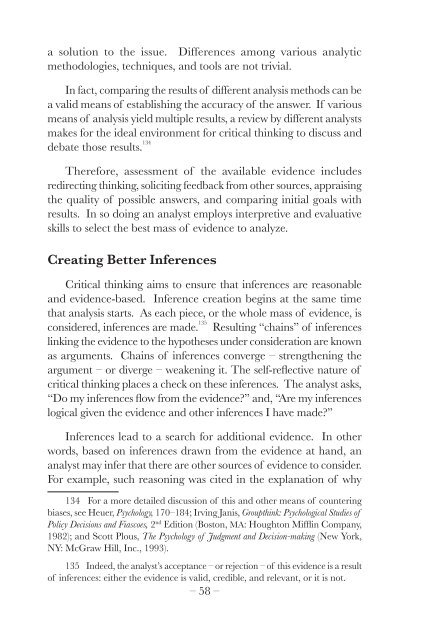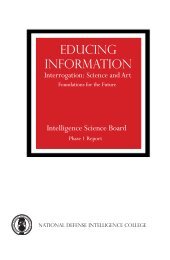Critical Thinking and Intelligence Analysis
Critical Thinking and Intelligence Analysis
Critical Thinking and Intelligence Analysis
You also want an ePaper? Increase the reach of your titles
YUMPU automatically turns print PDFs into web optimized ePapers that Google loves.
a solution to the issue. Differences among various analytic<br />
methodologies, techniques, <strong>and</strong> tools are not trivial.<br />
In fact, comparing the results of different analysis methods can be<br />
a valid means of establishing the accuracy of the answer. If various<br />
means of analysis yield multiple results, a review by different analysts<br />
makes for the ideal environment for critical thinking to discuss <strong>and</strong><br />
debate those results. 134<br />
Therefore, assessment of the available evidence includes<br />
redirecting thinking, soliciting feedback from other sources, appraising<br />
the quality of possible answers, <strong>and</strong> comparing initial goals with<br />
results. In so doing an analyst employs interpretive <strong>and</strong> evaluative<br />
skills to select the best mass of evidence to analyze.<br />
Creating Better Inferences<br />
<strong>Critical</strong> thinking aims to ensure that inferences are reasonable<br />
<strong>and</strong> evidence-based. Inference creation begins at the same time<br />
that analysis starts. As each piece, or the whole mass of evidence, is<br />
considered, inferences are made. 135<br />
Resulting “chains” of inferences<br />
linking the evidence to the hypotheses under consideration are known<br />
as arguments. Chains of inferences converge – strengthening the<br />
argument – or diverge – weakening it. The self-reflective nature of<br />
critical thinking places a check on these inferences. The analyst asks,<br />
“Do my inferences flow from the evidence” <strong>and</strong>, “Are my inferences<br />
logical given the evidence <strong>and</strong> other inferences I have made”<br />
Inferences lead to a search for additional evidence. In other<br />
words, based on inferences drawn from the evidence at h<strong>and</strong>, an<br />
analyst may infer that there are other sources of evidence to consider.<br />
For example, such reasoning was cited in the explanation of why<br />
134 For a more detailed discussion of this <strong>and</strong> other means of countering<br />
biases, see Heuer, Psychology, 170–184; Irving Janis, Groupthink: Psychological Studies of<br />
Policy Decisions <strong>and</strong> Fiascoes, 2 nd Edition (Boston, MA: Houghton Mifflin Company,<br />
1982); <strong>and</strong> Scott Plous, The Psychology of Judgment <strong>and</strong> Decision-making (New York,<br />
NY: McGraw Hill, Inc., 1993).<br />
135 Indeed, the analyst’s acceptance – or rejection – of this evidence is a result<br />
of inferences: either the evidence is valid, credible, <strong>and</strong> relevant, or it is not.<br />
– 58 –
















